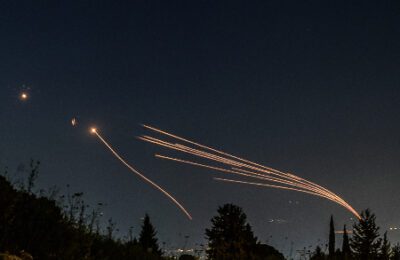 The historic BMH synagogue building on 16th and Gaylord St. is alive with the sound of construction.
The historic BMH synagogue building on 16th and Gaylord St. is alive with the sound of construction.
The once majestic structure was a beacon of Jewish life in downtown Denver from its dedication in 1921 until 1969, when the congregation moved to South Monaco.
After the BMH property was sold, it witnessed multiple and generally unsuccessful incarnations.
This time around, the grand old synagogue will not house Jazzercise classes or ethnic cultural centers or other half-baked projects that never got off the ground.
Church in the City, a Christian congregation that met in a former Safeway on Colfax and Josephine for many years, bought the building in September.
But the church is not merely trading one space for another.
BMH is being restored to its original physical beauty brick by brick, sconce by sconce, stained glass window by stained glass window.
Michael Walker, CICs senior pastor, waits beneath the façade that still proclaims Beth Hamedrosh Hagodol in elegantly carved stone.
Walker can barely contain his excitement.
Denver Jews are a bit more wary.
Some are pleased that BMH once the spiritual home to thousands of Jews is being rescued from prolonged disgrace.
Others remain skeptical because of the religious ideology motivating the renewal.
That ideology is not only Christian, but messianic which elicits negative feelings from some members of the community who grew up in the old BMH.
Once thing is clear. In a couple of months, BMH will look almost like it did when it was one of the most prominent buildings in Denver.
When Walker first saw the inside of BMH last winter, he was appalled.
Everything was covered in pigeon droppings. Satanic messages and graffiti snaked along the walls.
Undeterred, Walker and his church decided to buy the property.
Walker has carefully studied archival photographs, architectural renderings and newspaper clippings of BMH during its heyday.
He saw the stained glass windows that were moved to Monaco and are now being faithfully reproduced to go inside the old sanctuary.
Were making this place into everything it was supposed to be, Walker says. It has been vacant and void of any type of G-dly worship for decades. Right now its a junk pile but were going to make it beautiful.
While funding to restore and update BMH is pouring in from many sources, the Anschutz Foundation is the major contributor.
Walker says that CICs membership is very diverse: whites, African-Americans, Latinos, Africans, rich, poor, educated and uneducated.
CICs outreach to at-risk youth, teen parents, the needy and homeless has become a model for area churches.
Groups as diverse as East High, Urban Youth Ministries and Bill McCartneys The Road to Jerusalem Foundation heartily endorse CICs purchase of the BMH property.
Walker describes Church in the City as a non-denominational church with a Jewish bent. Our members understand that the whole Christian faith was Jewish to begin with. We already observe Passover and Sukkot, and Ive done Passover seders in Latin America, Europe and the Czech Republic.
Our members will love worshipping in a synagogue. Thats all Christians used to do in the beginning.
In this respect, CIC resembles many churches that are trying to make a deeper connection to what they view as the Jewish foundations of Christianity.
But theres more to the story.
Michael Walker, who was born Jewish, is a messianic Jew, who believes the messiah has already come.
Bringing his flock into one of the most historical synagogues in Denver Jewish history is the fulfillment of a personal dream. It also signals the start of a branch messianic congregation called Synagogue Beth Abraham, named after his Orthodox grandfathers shul in the Bronx.
Both Beth Abraham and CIC will hold services at BMH Beth Abraham on Saturday, and CIC on Sundays.
I believe Beth Abraham is going to be big, says Walker, who is 63.
I dont want to cause distress to the Jewish community, he says, cognizant of Jewish animosity toward the messianic movement. And I understand that they might have objections. Ninety-nine percent of Jews are still waiting for the messiah.
But I dont knock on peoples doors. I dont proselytize. That has never been done to me, and I would never do it to anyone else.
Walker says the majority of comments hes heard from the Jewish community are positive.
Sure, there will be other reactions, given my background, he concedes. But for the most part, I think anyone who had a history with and love for this place will be pleased.
Inside the BMH entryway, workers tip their hard hats. Hammers pound. Drills spin. The smell of fresh paint chokes on dust and memory.
The main entrance will be transformed into a wall of Jerusalem stone, Walker points. It will be like the Western Wall. People can insert their prayer requests, which will be periodically taken to Israel.
A large screen monitor will broadcast life from the Western Wall 24 hours a day.
It will be like walking into the Holy Land, he says.
Temporarily hidden beneath protective cardboard is the circular stone mosaic that countless feet avoided out of respect each time they entered the synagogue: BMH 1897.
That was the year the Orthodox congregation was founded.
The room behind the main entrance, which church members already call Fellowship Hall, is where CIC will feed up to 600 homeless individuals each month.
Navigating through wires and equipment, Walker enters the old BMH kitchen, where workers have exposed the original 1919 brick wall.
Walker then climbs three flights of sanded stairs that are in the process of being repainted and arrives at the main sanctuary.
Even with all the tools, movement, noise and general disarray, the old BMH sanctuary resonates with long ago Bar Mitzvahs, weddings, funerals and Shabbat prayers.
The altar, painted the color of Jerusalem stone, is virtually complete. A fixture that will soon become the Eternal Light hangs above the old ark. Someone is donating Torah scrolls that will go inside the ark.
Despite the surrounding activity, light streams undisturbed from the enormous windows on either side of the sanctuary.
Nothing not even the ghosts of garbage, overturned tables, obscene drawings and decades of neglect has diminished the synagogues visceral impact.
The sloping wood floor is covered with building paraphernalia, but soon chairs provided by the Buell Theater will be set up.
The large chandelier, which dates back to 1921 and is awaiting restoration, rests on a secured platform.
The IJN contacted members of Denvers Jewish community especially those who remember BMH in its glory days to get their reaction to the messianic presence at the emotionally laden Jewish landmark.
Most say that the overdue restoration of BMH is excellent news.
They are not concerned that a church will occupy the property.
But the fact that a messianic Jew is primarily responsible for this transformation gives them pause.
Sterling Kahn, who was president of BMH-BJ from 1985-1987, joined BMH on Gaylord Street in 1952.
I have wonderful memories, he says. My wife and I were married there in 1946 by the late Rabbi Charles E. H. Kauvar. My daughters were named on the bimah. My wifes grandparents were members.
I delighted in the whole ambience of BMH. It was an incredibly beautiful building. Its very nice to see that its being restored.
Kahn lauds CICs work with the homeless, which will continue at BMH. As far as Im concerned, if they have a congregation that reaches out to the homeless, thats a good thing.
And even though there is a messianic influence, let them do their thing the way they want to do it.
Informed that Walker wants to extend an invitation to the Jewish community to attend the dedication ceremony, Kahn says he would not accept.
I would not participate in anything they do there, he says. But I would like to walk through and take a look sometime.
Shalom Al Yisraels Rabbi Howard Hoffman, who had his Bar Mitzvah at BMH, says that his initial response to Church in the Citys efforts to revive the synagogues unique grandeur is quite positive. I dont care who Michael Walker is.
A restored BMH is better than having it be a storehouse or garage. Think of all the things that have been there since the congregation moved in 1969, he says.
Once you sell a shul, you have no other claims on it, Rabbi Hoffman says. Lots of shuls were sold to churches. Lots of shuls meet in churches. I dont think theres an issue here.
H. Michael Miller grew up at the old BMH. A past BMH-BJ president and current board member, he says that while having a messianic influence at the historic synagogue is far from ideal, the physical benefits of renovating BMH are significant.
If I had my druthers, a messianic congregation would not be my choice, he says. Still, any emotional attachment I had to the old location was disconnected some time ago.
The place has been put to so many uses through the years some not very flattering. So repairing BMHs physical structure is great. But running something messianic out of there? I dont like the messianic movement, period.
Others feel even more strongly.
I am filled with an overwhelming feeling of sadness, says one community member who was Bar Mitzvah at the old BMH and prefers to remain anonymous.
Its as if all the powerful teachings of Rabbi Kauvar and Rabbi Adelman, which still fill that space for me, will be violated. I cant make my peace with it.
In the balcony area, as whirring machines periodically drown out his voice, Walker recounts his religious evolution.
He was raised in the Bronx, where his Orthodox grandfather had his own shul, Beth Abraham.
When Walker was about 14 a year after his Bar Mitzvah the family brought his terminally ill grandfather to live at their home.
He stayed in my room, Walker remembers. I watched my grandfather pray every night in Hebrew, he says. I didnt understand much Hebrew, but I knew he was praying to the messiah.
Thirty-seven years ago, Walker had what he describes as a sovereign revelation.
I am convinced that the messiah my grandfather was praying for was the messiah I met in 1972 in California, says Walker, who shares his story with numerous messianic organizations throughout the country.
Asked whether its possible that his dying grandfather was praying for the moshiach, the Jewish messiah, Walker nods slightly.
Its possible, he says. But I cant deny what happened in my heart in 1972.
Im not a rabbi, Walker says. Im a Jewish pastor, or however you want to put it. I dont convert people. But if people ask me what I believe, Ill certainly talk to them about it.
Once construction on BMH is completed in January or February, Synagogue Beth Abraham will hold weekly Shabbat services.
According to Walker, the services will have a definite Hebrew orientation in music and prayer. There will be Israeli dancing, and well also blow the shofar.
Although Michael Walker anticipates objections to his messianic beliefs, he hopes that Denvers Jewish community will be able to appreciate the hard work that Church in the City has invested in their once beloved synagogue.
I dont want people to have a problem with me, but I understand where they are at, he says. If they say, Michael, I love what youre doing to the place, Ill be happy. If they take offense, I will understand.
Walker says hes met several Jews who went to Hebrew school or were Bar Mitzvah or married at BMH.
One day a man came in with a camera to take photographs, he says. He told me he was disappointed when the building became an Indian Center and Irish Center.
When I told him our church had bought the property, he said, Well, thats better than nothing. Then I told him that we were restoring everything to its original grandeur, and he became excited.
I am very sensitive to the Jewish community, he says. But from Jazzercise to the cultural centers to people who thought about putting in town homes and condos, no one has tried to restore BMH. Were excited we have the opportunity.

















bs”d Feh. You’re normalizing this? What made the old BMH special was Kiyum HaMitzvot, not physical beauty. The beauty was to inspire Kiyum HaMitzvot. There is a commandment, numbeer two, ‘Thou shalt have no other G-ds before Me.’ It’s okay for Gentiles to be Christians, but once they call themselves Jewish, or Hebrew, and then try to draw in Jewish people and say, ‘here is your Judaism’ … no, thank you. The 2nd Commandment is pretty imiportant, I never saw a commandment ‘thou shalt restore Jewish buildings at the expense of the prohibition of the worship of any deity who is not the one ineffable G-d Who has neither semblance nor form.’ We are never allowed to sell a synagogue that it may become a church. Condos would not violate that. Once it’s been mekadesh it can’t go downhill. Maalen b’kedusha! Especially a church that confuses Jews and Gentiles as to who they are and where to draw boundaries! AIM was no problem, as far as I know, because they believe in the Great White Spirit and there are beliefs in Judaism that do not one hundred percent contradict their belief that animals and plants also have some level of spirituality. For more info you can look that up on chabad.org. The difficulty with the ‘Hebrew-Christian’ idea is, despite the fact that we know the Nazarene to have been a Jew, and to have therefore had a pintele Yid and to have striven to serve G-d to the best of his understanding and ability, to worship him and to canonize his teachings, for Jews, is not okay because it sets him up as an intermediary. We can’t have that. We stand alone every day and on judgment day with G-d Himself deciding if did right or wrong There’s no hiding in the caftan of this lone preacher who lived about 2000 years ago. He cannot get us off the hook. Additionally, it’s so jarring. How many of the ancestors of the erstwhile congregants of BMH a”h were descendants of Jews who were tortured and killed because they would not worship him, and witnessed the burning of Torah scrolls and shuls, and, perhaps, of their own relatives? My neshoma wants to barf.
There is no commandment that says ‘thou shalt save thine Stained Glass Windows’ or ‘thou shalt save the candelabras that shone in thine former shul’. What about neshamos? A travesty for both the souls of Jews, and the souls of Gentiles, who get involved. The RaMChaL said, as recorded in Derech HaShem, that Hashem will be back in 6000. He won’t be too happy. He will see that Denver was barking up the wrong tree. Only 217 years to clean up this mess, and less if Kepler’s calendar turns out to be correct. Due to the change in the length of a year, since Biblical times, according to Kepler, the year 6000 will come in the Gregorian year 2024. Time to wake up and smell the coffee.
And, did you see the deal about the ‘mikveh’, which is also the ‘baptismal font’? Where is the Denver mainstream Jewish community barking to, to normalize this?
bs”d Not to bash Christianity. We share so many perspectives, values, and goals. But, there is halacha. And to quote what my Rebbe z.tz.l. on the West Side, said of halacha, ‘It works.’ And the NT sometimes seems like a kitzur of Torah, but, in many ways it might not be, if one looks deeper. Anyone who had the good fortune to be born Jewish, or to convert to Judaism, should never settle for less. So, there’s always a matter of fine-tuning, re-evaluating goals and perspectives, to get ready for what is coming. I am not a b’vadai person, regarding any individual, who is or is not Moshiach. We will find out, when we get there, who it is. I mean, to the Revelation of his presence. We know that in every age there is someone who is Moshiach, but until people become more in compliance with the requirements of Torah from Sinai, that individual cannot safely or effectively reveal himself. So, one is born and lives out his life and passes from the physical existence, and another, younger individual then carries that tafkid, unknown to most as to who he is. If i am ever accepted to the Second Tekufah, I will probably be in the very back row, and won’t even know who Moshiach turned out to be. Until then, there is halacha, for Jews, and, the Sheva MItzvot, for non-Jews. And if we don’t have a perfect set-up in life to do all of our mitzvot, we have to do like all other mortals; we punt.